Editors note: We don’t share the view that public art has to come from within the community it is intended for, but Margaret Lindsay Holton makes a number of critically important points in this column and we welcome the opportunity to make her informed views available.
BURLINGTON, ON September 10, 2012 According to the City of Burlington’s Public Art Master Plan 2009-2018 (aka PAMP), the most important thing about public art is its purpose. “Public art is a force for place making – for expressing and evoking connections among people and places that are meaningful to the community and civic life.” It goes on, “Public Art has been recognized as a significant tool for building livable cities, for urban beautification, and for economic development”
“A successful Public Art Program makes public space more attractive, interesting, and comfortable, resulting in benefits for both residents and visitors. Beyond these tangible results, the process of creating public art within a framework, that includes community input, can lead to far-reaching social benefits. This is not simply about creating something for the community; instead, it is about creating community”.
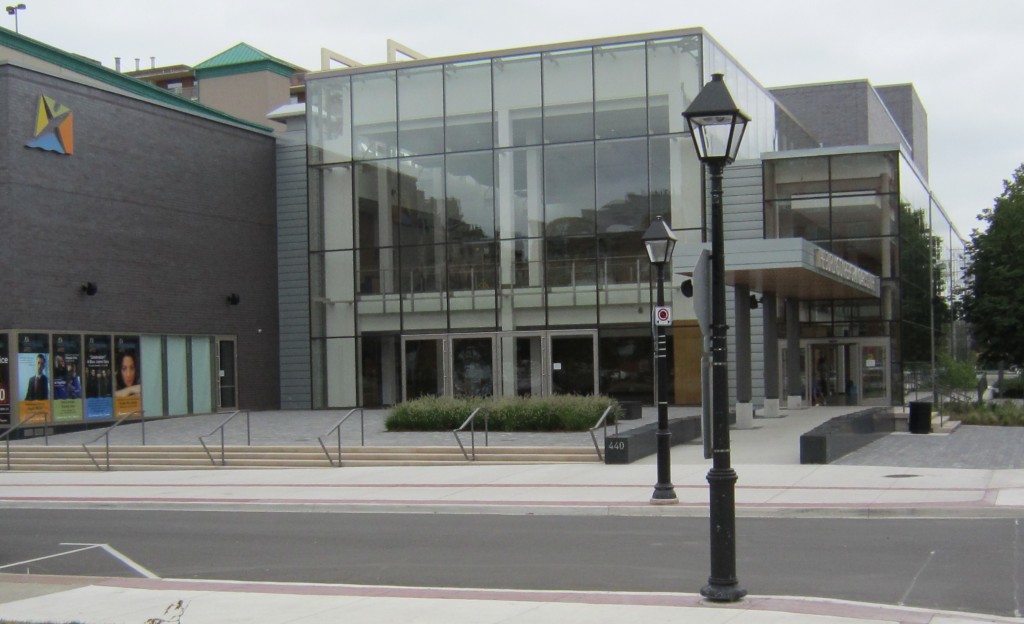
Burlington based artist and Our Burlington columnist Margaret Lindsay Holton wants to see Burlington artists at least considered in the selection process. None of the artists who made the final three are from Ontario. One is from Quebec, one from New Brunswick and the third from Maine, USA. Photo by Our Burlington
It concludes, “By reflecting a community’s values, and its past, present, and future, public art can embody and symbolize a community’s sense of identity.” (Italics mine.)
According to the public survey done for this Master Plan, Burlingtonians overwhelmingly identify with the thematic subject of “local history”, followed closely by “the natural environment”. Take note of that – ‘local history’ and the ‘natural environment’. We will be coming back to those two heartfelt perfectly natural themes of identity in a moment.
So, just so you that know, the above was, and remains on the City of Burlington website as, the stated purpose of the City of Burlington’s ‘Public Art’ initiative.
However, most interesting about Burlington’s Public Art Master Plan was City Council’s abdication of the responsibility for actually running the Public Art program. Instead, Council voted, in 2009, to let an ‘external body’ handle it. And there, to my mind, lies a bit of a problem. An ‘external body’ active in Burlington, is one thing, but an ‘external body’ outside of the City limits is quite another.
In 2009, the City’s Public Art Reserve Fund had $186, 578 on account, with another $190,000 ‘pending’. Today, that annual fund, topped up by various agencies of the Government of Ontario, has allocated approximately $250,000 to that ‘external body’ in the form of one Jeremy Freiburger, Chief Cultural Strategist of Cobalt Connects, of Hamilton, Ontario, Canada.
Mr. Freiburger was hired by the City of Burlington to implement not only Burlington’s Public Art program but, latterly, a Cultural Action/Policy Plan too. Jeremy certainly is an engaging and charming fellow who is struggling somewhat to ‘make it happen’ here, BUT, why didn’t City just align with the long-established ‘Creative Burlington’ group? You know, the group that had to close shop in 2011 because there was insufficient City funding for them to continue to operate. With no track record in this community, Jeremy Freiburger’s Cobalt Connects, has, within just three very short years, received over TEN times the funding that the grassroots ‘Creative Burlington’ group was begging for from Council to stay afloat.
…. hmmmm ….
How can a Public Art program in Burlington, one that is both meaningful and significant for developing a ‘rooted’ Burlington identity, be developed by, and decided by, an ‘external body’ from outside the City limits? In other words, WHY does the City of Burlington have to go to a self-professed “entrepreneurial” Hamilton-based arts-bureaucrat to FIND the Roots of our own cultural identity?
Something is missing in this cultural equation. That missing component is, in fact, us, the actual living breathing communities that comprise the City of Burlington – from established Aldershot to newly developed Alton, from rural Lowville to the developed Lakefront, from tony Tyandaga to solid Mountainside, from sprawling historic farmlands of the north to the apartment blocks and heritage roosts of the downtown core. Within this Public Art ‘dialogue’ we, as Burlingtonians, are sadly missing the one element that makes Burlington so culturally unique, our very own voices.
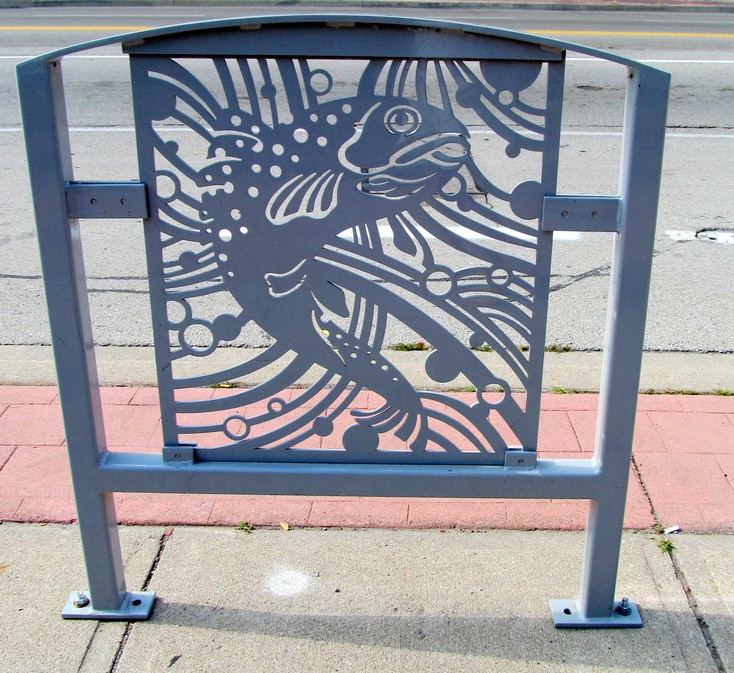
Yes, they are bike racks. You won’t get arrested or ticketed for attaching your bike to one of them.
One of recent Burlington Public Art initiatives, of 2010, administered by Jeremy, was the development of these bike racks. Yes, that is what they are. (Promise, you won’t get arrested or ticketed for locking up to one.) Over 180 designs were submitted by 76 ‘international’ artists until 10 designs, chosen by Jeremy and his appointed ‘independent’ jury, were placed on a shortlist. After a public vote, six finalists were paid $1500 each for those designs – Martyna Dakowicz, Jen Hsieh, Zhiyang Mao, Kyle Reed, Wesley Tsang, and Xiaojing Yan. Not one is an active Burlington-based artist, or has ‘roots’ here. Perhaps that is why these bike racks have FAILED on two accounts: 1) as bike racks – [have you ever seen ANY bike locked up to these objects over the past year?] and 2) as ‘local’ Public Art. Admit it Jeremy, few here have any idea what these cut-out metal thingys bolted to several downtown sidewalks are all about …
The Palladium Park Public Art Benches Competition of 2011 was no different. A talented artist from Kitchener-Waterloo received the commission, not one of Burlington’s own.
Sure, call me parochial, but how, exactly, can the heralding of Burlington’s cultural spirit, local history and natural landscape begin with ‘outsiders’? It’s like having a paid professional singer sing our favourite childhood lullaby from a hastily composed score, rather then singing in chorus, with one heart and soul, by rote, what we all know and love so dearly. (A tad hyperbolic, but methinks you catch my drift.)
Surely the point of this exercise, in all its forms, is to celebrate our own, to support and promote the struggling ‘grassroots’ art community here, and by so doing develop and reflect a truly Burlington-based arts culture. No? On the other hand, perhaps the REAL Public Arts objective, as the ambitious Jeremy Freiburger and his select ‘external body’ of jurors interpret it, is not at all about the nurturing of, or the reflecting of, Burlington’s ‘sense of identity’, past or present. Rather, perhaps their end objective is simply to create a generic ‘urban beautification’ of Burlington for well-heeled out-of-towners (and investors) using titillating ideas by “recognized” artists who have no cultural or spiritual connection to this place. Or, perhaps, the purpose is to create a roster of “recognized” artists who, hopefully, (no guarantee), will someday garner an international reputation that will substantially inflate their monetary worth, and thus, increase the investment holdings of the City of Burlington Corporation’s Public Art Inventory. Perhaps. Who knows. One thing is clear, the PURPOSE of Burlington’s Public Art program is slowly, and somewhat stealthily, tip-toeing away from the standing Public Art Master Plan.
Anyway, for sake of argument, let’s assume for a bit that the REAL objective, (not the one so meticulously outlined in the PAMP), is to develop a no-name ‘pretty suburban city’ dotted with public art works by artists-from-elsewhere whose careers will continue to develop far away from the City of Burlington. With this revised concept in mind, we can better understand Mr. Freiburger’s jury’s choice of three finalists for the Burlington Performing Arts Centre Public Art Competition. More at the public art web site.
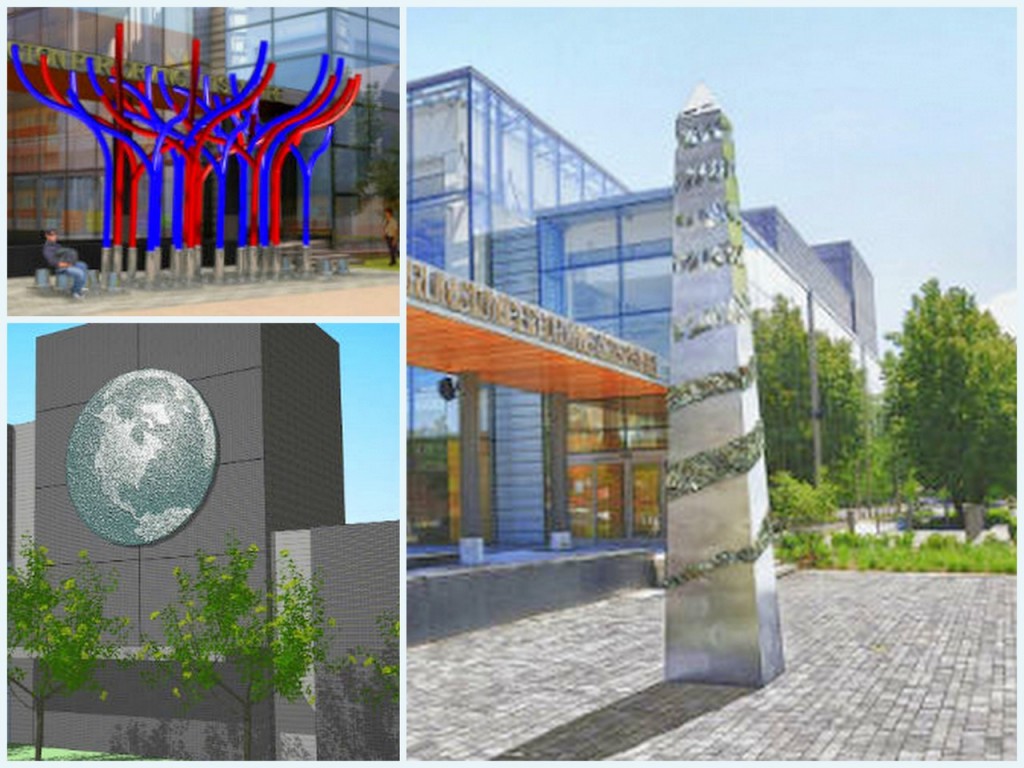
From the top left, going clockwise – the Cooke Sasseville submission, the Spiral Stella by Peter Powling and the In the Round by Aaron Stephan.
The three finalists with concepts, clockwise, are: Cooke-Sasseville from Quebec City. Concept: ‘Stay Connected’, 15ft x 7ft, an abstract ‘technical console with cables’. Peter Powling from “the hills of New Brunswick”. Concept: ‘Spiral Stella’, 16ft high x 30 inches wide, sky reflecting bronze obelisk. and Aaron Stephan from Portland, Massachusetts, U.S.A. Concept: ‘In the Round’, circular 28 foot disc covered with 15,000 pixel-people on globe. Not one of these evidently talented artists is from Burlington, or even the Golden Horseshoe region of Southern Ontario, Canada.
Obviously each artist has devoted a great deal of thought to develop a ‘Public Art’ concept that ‘reflects’ Burlington’s identity back to itself (sort of) and each idea stands as an indisputable ‘Burlington Public Art’ monument that will eventually engender local community pride and a long term legacy of some kind. Still, it seems a great pity to me that not one of these fine artists is from here. I mean, there isn’t even a finalist design concept from the very talented, locally-minded and “recognized” Les Drysdale, who, though admittedly not a Burlington native, is, at least, from the Golden Horseshoe region. His work can be seen on his web site.
How appropriate it would have been to have one of Les’s evocative story-evoking ‘local history’ statues grace the square at the Burlington Performing Arts Centre of, love him or loathe him, the indisputably talented Jim Carrey. Imagine a multi-dimensional fully animated vignette by Les – of Jim – as ‘The Mask’, the ‘Grinch’, and the ‘Joker’ characters all rolled into one piece. It would celebrate local talent on multiple levels, (Jim grew up in Aldershot), successfully promote the Centre as a ‘living’ arts showcase, inspire local and visiting performers, and nudge all of us, as a community as a whole, to identify with the ‘Dream Big’ ‘Just Do It’ persona of Jim. It would also, I believe, be an engaging and memorable tourist attraction. And it could all be done for the $90,000 commission prize fee. Ah well, simply put, this kind of ‘from here’ idea has not been “recognized” by the jury. And more’s the pity, I say.
Let’s re-consider all this, for a moment, from a slightly different perspective.
ZimSculpt is currently showing at the Royal Botanical Gardens (until October 8th). Two talented and soulful sculptors from the Shona tribe, Passmore Mupindiko and Patrick Sephani, are carving up million year old rocks especially imported for this exhibit from their home country, Zimbabwe, Africa. Now imagine that. They have imported huge hunks of stones from their own mountains to carve here. Voluptuous stone sculptures crafted by their own tribemen’s hands abound throughout the Hendrie Gardens. These bold sculptures really are powerful art objects: thematically, technically and culturally. Cumulatively, these Shona-made sculptures reflect a profound ‘sense of identity’, from a wholly unique place on the planet, Zimbabwe.
Now, flip it. Imagine a roster of Burlington-based sculptors (or artists), who are supported and “recognized” by our very own City Council (or equivalent ‘external body’ made up of Burlington art enthusiasts). Imagine them going to Zimbabwe (or France, or anywhere else) to showcase their powerful works in a high-profile public art space. Imagine them as they chip away at their own imported ‘mountain’ rock – the Niagara Escarpment. All who see – and buy from them – would know these talented artists reflect an equally profound ‘sense of place’. Why? Because these respected artists reflect another far off Earth location, one with a wholly unique natural and local identity. And yes, these soulful and talented artists ARE from that wonderful place of Burlington, Ontario, Canada.
…. Get the picture?
If we don’t believe in our own, nobody else ever will either.
Culturally-diverse earth roots are not only important, but essential. Without them, we just become rootless, isolated and detached global misfits, flipping the dials, pushing the buttons, endlessly searching … searching … searching … for the one place we so studiously ignore at our own communal peril – Home.
Ask Patrick, ask Passmore, those soulful Shona sculptors representing their far off village communities of Zimbabwe. Now, ask the diverse voiceless village communities who live harmoniously within the City boundaries of Burlington, Ontario, Canada. Ask the artists who live, work and play here. They, and we, all know that: not only does ‘Charity begin at Home’, but home really is where our Heart – and Art – is.
Margaret Lindsay Holton is both an environmentalist and a community activist. She is an artist of some renown and the designer of a typeface. She is also a photographer and the holder of opinions she will share with you in an instant. She appears as an Our Burlington columnist every two weeks.
© Photography and photo montages by Margaret Lindsay Holton, 2012, unless otherwise noted.














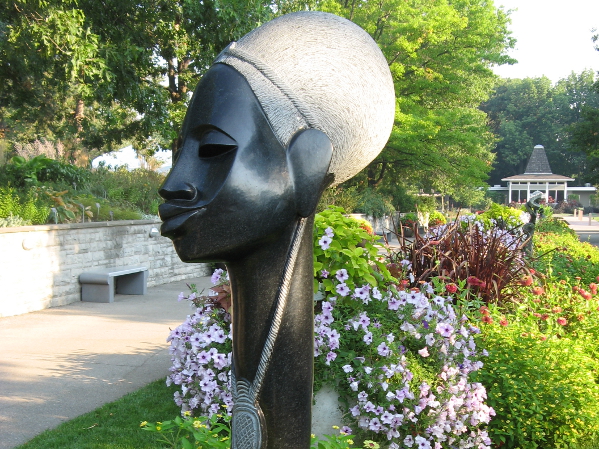
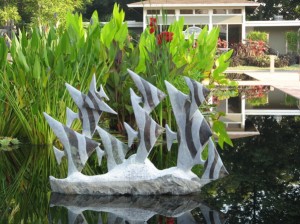






“Arts Council or Arts Advisory Committee” Could or should that not be the job of Burlington Arts Centre?
Dan Lawrie who fronted over $35,000 for this commission, is ‘just’ an interested Burlington arts enthusiast, not a board member of the BAC.
More the merrier ‘of his kind’ I say. Local business successes who champion local art efforts is a ‘win-win’ combination.
An ‘Art Council’ or ‘Art Advisory Committee’ made of such broad-minded & generous ‘local’ individuals would be helpful.
The jurors for the finalists of this competition (that had 119 entries) are: Ian Ross, executive director of the Burlington Art Centre, Emma Quinn, executive director of the Ontario Craft Council, Trevor Copp, artistic director of Tottering Biped Theatre, and Natalie Eldershaw, 4th-year Sheridan College art student.
Now the public ‘vote’….
Margaret Lindsay Holton, her comments are very well taken and reflect my own thoughts as well.
I would like to add that the jury’s choice of three finalists for the Burlington Performing Arts Centre Public Art Competition is very far off the mark.
Each individual artist submitted what they technically do best, not whats best for the Performing Arts Centre.
Sorry, but all three excellent designs are stand alone objects, two of which could find a home in a park and one on some North American Corporate building.
When I think of the Performing Arts, I feel an uplifting spirit an awe, inspiration and imagination mixed with emotion.
The public should be able to recognize and interact with the art work from a distance or up close.
Give me motion, texture, presence, sound, symbolism anything that implies the spirit of performance entertainment.
A great design or idea by a novice from near or far can always be outsourced for the right expertise in its execution and within budget locally.
Cheers!
This is slightly off topic but I’ve been busy trying to track down a person I used to work with named Margus Lee. This article and comment are as close as I’ve come. So is this Margus Lee the one that used to work at Kelley Advertising in Hamilton
Well said Teresa.
To clarify, the ‘Les Drysdale – Jim Carrey’ suggestion was just that. My point is, as you say, there IS talent here, that, with ‘local’ support, could easily flourish. Art in Action has successfully demonstrated that.
Keep up the good ‘grassroots’ effort!
While it is important for local artists to participate in their community public art programs, their environment must provide opportunities for them to learn to be competitive. After administering public art programs for the last 25 years in Hamilton and Kitchener, it’s become clear to me that artists wishing to make public projects must have the experience and training necessary to do this. This is why most projects are national or international in their call for artists. There is a very small pool of local artists capable of successfully completing the projects they propose. It’s a matter of scale, engineering/installation resources, weather- and vandal-proofing, and ability to carry the necessary insurance coverage. Talented local studio artists are not always able to make the leap to public projects. I found a very small pool of regional artists able to be competitive in a call for proposals. What’s the solution? A necessary part of public art programming in any community must be the education and training of artists. In addition, the real cost of any public art project must allow for the artist to make some money. How many large-scale projects have I seen where artists end up, after fabrication and other sub-contracting costs are factored in, without any money from the project? Too many to count. Public art is essentially a very complex field. Community relevance through the input of local artists is one factor in making a program really work well but there are other considerations at play too.
Very true Cheryl. I do agree that an ‘in-house’ Arts Council or Arts Advisory Committee of some kind would benefit local artists who aim higher then just a local market, if they do lack the requisite skills to compete on a grander scale.
That said, at the end of the day, it really is the IDEA that should triumph.
I can appreciate that artists can get in over their heads, underestimating costs, or even low-balling in the hope of ‘winning’. But that is the ‘business’ of art, and in that sense, is really like any other business. You win some, you lose some. You survive or you perish. Maintaining a livelihood as an artist is precarious at the best of times. And, seasoned or not, the only way to learn IS by ‘doing’.
In this particular instance, a longer lead time and more local advertising after the Call for Submissions may have encouraged a greater and better ‘local’ response. And equally, an open-mindedness by the judge and jury to consider ‘newbies’ IDEAS may have gotten us better and more locally relevant results then we are currently faced with.
Yes, it is a complex business. But just because it is, we shouldn’t be deterred from trying to achieve the BEST results for the community. The unknowns and the variables will always exist, (look at the mind-boggling pier situation), but that doesn’t mean that every ‘untried’ activity or person can’t provide an engaging solution.
A little leap-of-faith all round can achieve some amazing results.
There is an abundant of talented local artists here in Burlington. I’m also questioning why Creative Burlington was not given the job to decipher our creative culture. Deb Tymstra is still a vital contributor to the local scene with her Art’s Matter cable program and has been nothing but helpful in her exposure of Art in Action’s Burlington Studio Tour, of which I am both an artists and an organizer.
No slight to Jeremy. I believe he has, almost single handily, taken Hamilton from the depression it was once in to a vibrant artistic hub. And although Burlington could learn from this, we are not Hamilton. We do not have the same empty, derelict buildings that can be converted to art meccas. Unless of course you’re referring to the Village Square. I priced a studio in there last year but the property managers are asking for retail prices. No artists can afford that. Perhaps the City could subsidise the rent costs and make it a real artistic village. Just in case Jeremy is reading…
Our group Art in Action has found it easier to organize, fund and execute our own tour as there seems to be no avenues for assistance for us by the City of Burlington. Many local businesses of Burlington are more than willing to assist us with sponsorship, proving to us that the desire to have a thriving arts scene is here.
I question if it is the culture that the Burlington Art Centre has fostered in the city that appears as though we have no local artists?
Did Les Drysdale submit a design? If so can we see it? Is Margaret saying that one finalists spot should be held open for local artists? As an artist I will continue to submit ideas for public art, where appropriate, and hope that it will be accepted on it’s merit not because I live here. However I do agree that it would illustrate communtiy support if at least one finalist spot could be held if a local artists submitted. The community could then be asked to decide its merits not the appointed jury.
There is a very large and supportive network of talented local artists in this community and we will continue to create our art and spread the word to the rest of the community public art calls or not.
Teresa Seaton